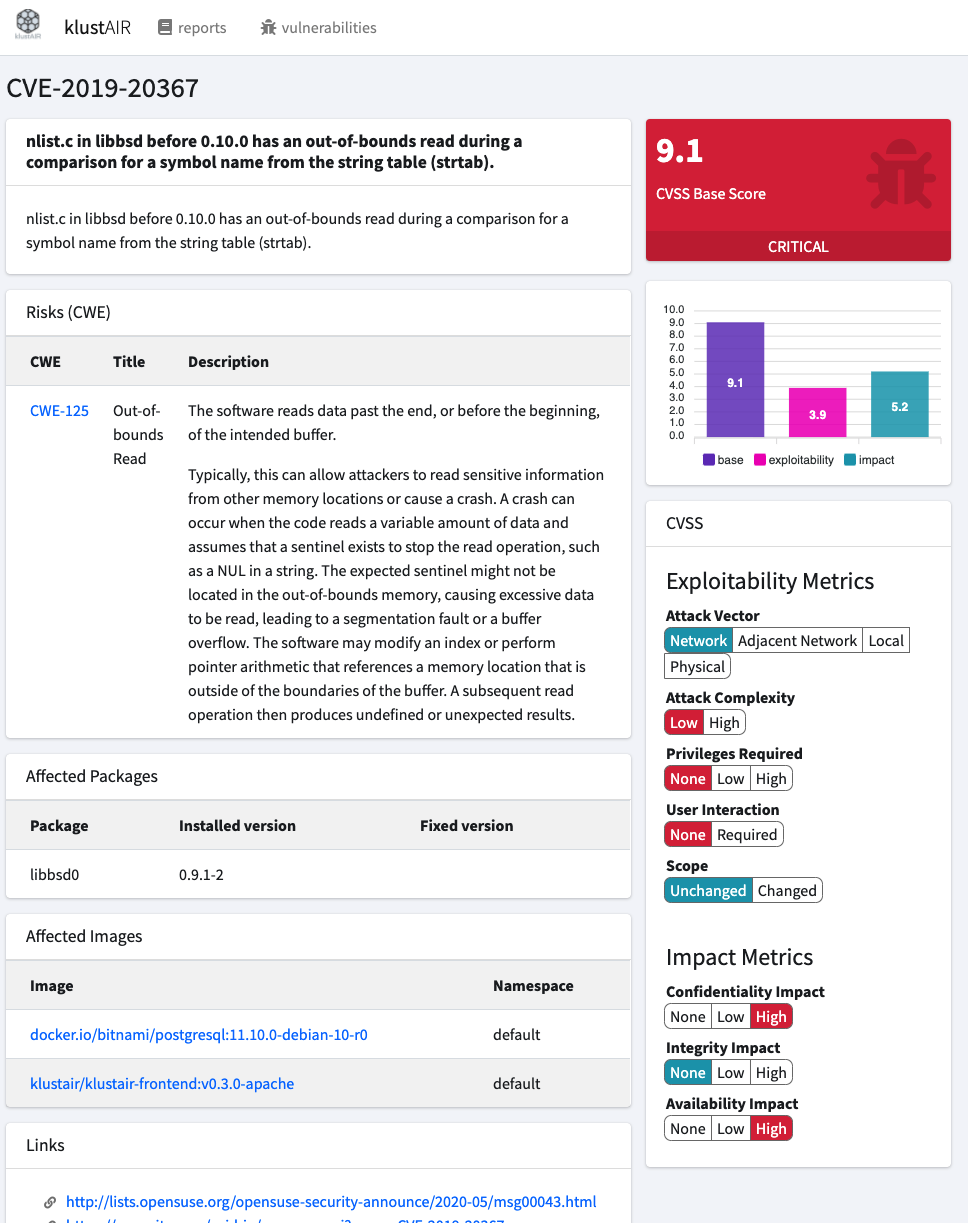Helm chart do deploy klustair with anchore

Klustair collects all the used images your Kubernetes namespaces and runs a trivy scan on them.
Demo : https://klustair.herokuapp.com/

Read the upgrade instructions here
The key consists of 32 random characters
Chose one of the following commands to generate one or copy the Laravel key from https://wwww.keygen.io
dd if=/dev/urandom bs=1 count=32 2>/dev/null | base64
or
date +%s | md5 | base64 | head -c 32 ; echo
of
openssl rand -base64 32
export RELEASENAME=my-klustairkind create cluster --config kind.yamlkubectl apply -f https://raw.githubusercontent.com/kubernetes/ingress-nginx/main/deploy/static/provider/kind/deploy.yamlkind export kubeconfig --name klustair --kubeconfig ./kubeconfighelm install $RELEASENAME ./klustair -f ./klustair/values.yaml -n $RELEASENAME --create-namespace --set-file klustair.kubeconfig=./kubeconfig
You should be able now to access your installation via http://local.klustair.com (pointing to 127.0.0.1) or the defined URL in values.yaml.
the Klustair Admin credentials a visible in first Database init run. If you lost your Admin Account or need more Accounts use the “php artisan klustair:user” command on apache or php-fpm pod.
helm listhelm uninstall $RELEASENAMEkind delete cluster $RELEASENAME
trivy.repoCredentials and klustair.gcloudCredentials are optional
export RELEASENAME=my-klustairhelm repo add klustair https://klustair.github.io/klustair-helmhelm install \--set klustairfrontend.url=your.klustair.domain.com \--set klustairfrontend.appkey=base64:<put your generated Laravel key here> \--set-file klustair.kubeconfig=/path/to/your/kubeconfig \--set-file trivy.repoCredentials=/path/to/your/repocredentials.json \--set-file klustair.gcloudCredentials=/path/to/your/gcloudcredentials.json \$RELEASENAME klustair/klustair
Follow this instruction to generate Google Serviceaccount and credentials
https://ahmet.im/blog/authenticating-to-gke-without-gcloud/
export RELEASENAME=$(helm list | grep klustair | awk '{print $1}')kubectl delete secrets $RELEASENAME-configskubectl create secret generic $RELEASENAME-configs \--from-file=kube.config=/path/to/your/kubeconfig \--from-file=repo-credentials.json=/path/to/your/repocredentials.json \--from-file=gcloud-credentials.json=/path/to/your/gcloudcredentials.json
https://github.com/klustair/klustair/blob/master/repo-credentials.json.example
You find a full list of all Chart values here:
https://artifacthub.io/packages/helm/klustair/klustair?modal=values-schema
| Key | Type | Default | Description |
|---|---|---|---|
| image.repository | string | klustair/klustair |
repository of the klustiar runner |
| image.repositoryFrontend | string | klustair/klustair-frontend |
repository of the klustair frontend |
| image.tag | string | v0.2.2 |
|
| image.pullPolicy | string | Always |
|
| klustairfrontend.appkey | string | example key | Laravel App Key |
| klustairfrontend.url | string | example URL | Frontend URL |
| klustair.kubeconfig | multiline string | example config | kubectl configuration |
| trivy.enabled | boolean | true |
|
| trivy.timeout | string | "2m0s" |
|
| trivy.repoCredentials | multiline string | example JSON | |
| postgresql.postgresqlUsername | string | klustair |
|
| postgresql.postgresqlDatabase | string | klustair |
|
| postgresql.persistence.storageClass | string | "-" |
|
| postgresql.persistence.size | string | 1Gi |
|
| postgresql.resources.requests.memory | string | 256Mi |
|
| postgresql.resources.requests.cpu | string | 250m |